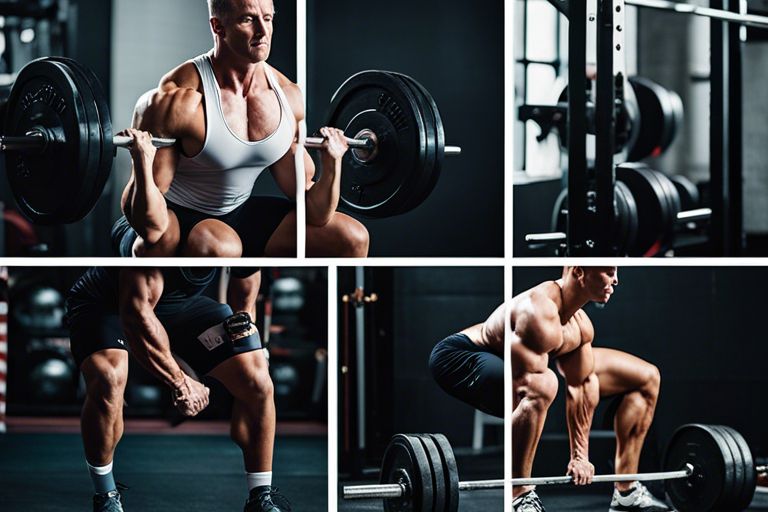You have conquered the basics of lifting, now it’s time to investigate into the advanced techniques that can take your strength training to the next level. In this guide, we will explore effective methods that can help you maximize your strength gains while minimizing the risk of injury. Whether you are looking to increase muscle mass, improve athletic performance, or simply push your limits, mastering these techniques will elevate your lifting game. Let’s unlock the secrets to reaching your full potential in the gym.
Key Takeaways:
- Varying Rep Ranges: Incorporating low, medium, and high rep ranges into your lifting routine can help target different muscle fibers and promote overall muscle growth.
- Utilize Supersets: Supersets, where you perform two exercises back-to-back with minimal rest, can be an effective way to increase intensity, save time, and challenge your muscles in new ways.
- Focus on Progressive Overload: Continuously increasing the weight you lift over time is crucial for building strength and muscle mass. Tracking your progress and pushing yourself to lift heavier weights will lead to continuous gains in strength.
Leveraging Biomechanics for Optimal Power
If you want to unlock your true strength potential and maximize your power output in resistance training, understanding biomechanics is key. By leveraging the principles of biomechanics, you can optimize your technique to generate maximum force and achieve peak performance in the gym.
The Role of Leverage in Resistance Training
Any experienced lifter knows that leverage plays a crucial role in lifting heavy weights. Leveraging biomechanics effectively allows you to manipulate the lengths of your limbs and the positioning of your joints to your advantage, thereby increasing the mechanical advantage and reducing the amount of effort required to move the weight. This, in turn, enables you to lift heavier loads and target specific muscle groups more effectively.
Anatomical Considerations for Movement Efficiency
With a solid understanding of anatomical considerations, you can further enhance your movement efficiency during resistance training. By analyzing joint angles, muscle insertions, and lever lengths, you can identify the most efficient movement patterns for each exercise. This knowledge empowers you to optimize your form, reduce the risk of injury, and target muscles with precision for maximum gains.
Optimal execution of resistance exercises requires a deep understanding of how your body mechanics influence movement patterns and force production. By honing in on the anatomical considerations and exploiting the principles of leverage, you can elevate your training to a whole new level. Mastering these techniques can propel you towards new personal records and help you reach your strength and fitness goals.
Neuromuscular Adaptation Strategies
Understanding Motor Unit Recruitment
Understanding the concept of motor unit recruitment is crucial in maximizing your strength gains through advanced lifting techniques. Motor units are groups of muscle fibers and the corresponding motor neuron responsible for signaling them to contract. When you lift weights, your body recruits motor units based on the intensity of the exercise. The recruitment of motor units follows the ‘size principle’, where smaller motor units are recruited first for lighter loads and larger motor units are recruited as the load increases. By progressively overloading your muscles, you can train your body to recruit more motor units, ultimately leading to increased strength and muscle mass.
The key to optimizing motor unit recruitment is to focus on lifting heavy weights at a high intensity. Little by little, your body will adapt to the stress by recruiting more motor units to handle the load. This adaptation leads to greater strength gains over time. Incorporating techniques such as progressive overload, cluster sets, and forced reps can help challenge your muscles and stimulate further motor unit recruitment.
Central Nervous System Contributions to Strength
The central nervous system plays a crucial role in determining your strength levels. It is responsible for coordinating muscle contractions, balance, and stability during lifting. Strength training not only improves the strength of your muscles but also enhances the efficiency of your central nervous system. By consistently challenging your CNS with heavy loads, you can improve neural adaptations that ultimately lead to greater strength gains.
Periodization and Advanced Programming
Many advanced lifters often hit plateaus in their training progress. In order to continue making gains in strength and muscle mass, it is crucial to implement periodization and advanced programming techniques to keep the body adapting and growing.
- Periodization: Structuring your training into specific time frames to peak for competitions or set specific strength goals.
- Advanced Programming: Manipulating variables such as intensity, volume, exercise selection, and frequency to optimize training adaptations.
The Evolutionary Approach to Structured Training
To maximize your strength gains, it is crucial to follow a structured training plan that evolves over time. By progressively increasing the demands on your muscles, you stimulate growth and adaptation.
By following a systematic approach to training, you can ensure that you are consistently challenging your body to adapt and grow stronger. This evolution in your training plan will help you break through plateaus and continue making progress in your lifting journey.
Manipulating Variables for Progressive Overload
Variables such as intensity, volume, exercise selection, and frequency can all be adjusted to create progressive overload in your training. This means gradually increasing the stress placed on your muscles to force them to get stronger and more resilient.
Progressive overload is the key principle behind increasing muscle size and strength. By strategically manipulating these variables, you can ensure that your body is continually pushed to its limits and forced to adapt and grow stronger.
Nutritional Support for Enhanced Performance
All athletes and fitness enthusiasts know that a crucial component of maximizing strength and performance is proper nutrition. Fueling your body with the right nutrients can make all the difference in achieving your fitness goals. Whether you are a powerlifter, bodybuilder, or a weekend warrior, understanding the role of nutrition in enhancing performance is key to taking your training to the next level.
Fuelling the Machine: Energy Systems and Macronutrients
Performance in the gym is heavily reliant on the body’s energy systems and macronutrient intake. The three primary energy systems – ATP-PC, glycolytic, and aerobic – play a vital role in supplying energy during various intensities of exercise. Optimizing your intake of macronutrients such as carbohydrates, proteins, and fats can ensure that your body has the fuel it needs to perform at its best. Carbohydrates are the body’s preferred source of energy during high-intensity exercise, while proteins are necessary for muscle repair and growth. Fats provide a sustained source of energy during longer duration activities.
To maximize performance, it is important to tailor your macronutrient intake to your specific training goals and energy demands. Ensuring that you are consuming an adequate amount of each macronutrient will not only support your performance but also enhance your recovery and muscle growth. Working with a nutritionist or dietitian can help you create a customized nutrition plan that aligns with your training regimen and optimizes your performance in the gym.
The Micronutrient Genesis of Recovery and Growth
Enhanced recovery and muscle growth are intricately linked to the intake of micronutrients – vitamins and minerals that play necessary roles in various physiological processes. Ensuring that you are consuming an array of micronutrients through a diverse and balanced diet is crucial for supporting your body’s recovery and growth processes. Micronutrients such as vitamin D, magnesium, and zinc are particularly important for muscle function, immune health, and hormone regulation.
Plus, neglecting your micronutrient intake can hinder your recovery, impair your performance, and increase your risk of injury. Incorporating micronutrient-rich foods such as fruits, vegetables, nuts, and seeds into your diet can help you meet your body’s daily requirements and support your progress in the gym. Prioritizing micronutrient intake alongside macronutrient balance is necessary for achieving optimal performance and maximizing your strength gains.

Introducing Plyometrics and Explosive Movements
Not only is strength important in weightlifting, but also the ability to generate explosive power. Plyometric exercises and explosive movements are important for maximizing your strength potential and enhancing athletic performance. By incorporating these dynamic movements into your workout routine, you can take your training to the next level and achieve remarkable results.
Defying Gravity: The Physics of Plyometric Training
Any object on Earth is subject to the force of gravity, but in plyometric training, we aim to defy this force through rapid and powerful movements. Plyometric exercises involve stretching and contracting muscles quickly to build explosive strength. When you perform plyometrics, you store energy in your muscles during the eccentric phase (lengthening) and release it rapidly during the concentric phase (shortening), resulting in a powerful movement that can overcome gravity with ease.
The key to effective plyometric training lies in understanding the physics behind it. By harnessing the principles of energy transfer and muscle elasticity, you can amplify your strength gains and elevate your athletic performance to new heights. Explosive movements require precise timing and coordination to generate maximum power and propel your body upwards or forwards.
Synchronization of Muscle Fibers for Explosive Strength
Muscle fibers play a crucial role in generating explosive strength during dynamic movements. When you engage in explosive exercises, such as jump squats or power cleans, your muscle fibers must fire synchronously to generate maximum force. This synchronized recruitment of muscle fibers allows you to produce rapid and powerful movements that can translate into improved performance in sports and weightlifting.
Explosive strength is not only about raw power but also about efficiency in muscle recruitment and coordination. By training your muscles to fire in unison during explosive movements, you can enhance your speed, agility, and overall athletic ability.
To wrap up
Ultimately, mastering advanced lifting techniques is crucial for maximizing your strength and achieving peak performance in your workouts. By incorporating strategies like progressive overload, drop sets, and supersets, you can challenge your muscles in new ways and push past plateaus. Remember to always prioritize proper form and technique to minimize the risk of injury. With dedication and consistency, you can unlock your full potential and see significant gains in strength and muscle growth. Keep experimenting, pushing your limits, and never stop striving for improvement in your lifting journey.
FAQ
Q: What is advanced lifting techniques?
A: Advanced lifting techniques refer to specialized training methods and strategies used to enhance strength, power, and muscle development beyond basic weightlifting routines.
Q: Why is it important to maximize your strength?
A: Maximizing your strength is important for achieving peak performance in various athletic endeavors, preventing injuries, promoting overall health, and achieving personal fitness goals.
Q: What are some advanced lifting techniques to consider?
A: Some advanced lifting techniques include pyramid training, supersets, drop sets, rest-pause training, and incorporating advanced training equipment like resistance bands and chains.
Q: How can one progressively overload in advanced lifting techniques?
A: Progressively overloading in advanced lifting techniques involves gradually increasing the weight, volume, or intensity of your workouts to continue challenging your muscles and stimulating growth and strength gains.
Q: Is it important to have a structured training plan when practicing advanced lifting techniques?
A: Yes, having a structured training plan is crucial when practicing advanced lifting techniques to ensure progression, prevent overtraining, and optimize results. It is recommended to work with a qualified fitness professional to design a personalized program based on your goals and fitness level.

